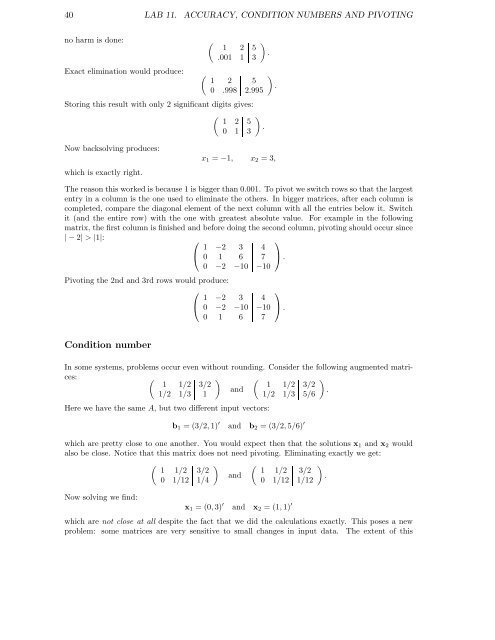Introduction to Numerical Math and Matlab ... - Ohio University
Introduction to Numerical Math and Matlab ... - Ohio University
Introduction to Numerical Math and Matlab ... - Ohio University
You also want an ePaper? Increase the reach of your titles
YUMPU automatically turns print PDFs into web optimized ePapers that Google loves.
40 LAB 11. ACCURACY, CONDITION NUMBERS AND PIVOTING<br />
no harm is done: ( 1 2 5<br />
.001 1 3<br />
Exact elimination would produce: (<br />
1 2 5<br />
0 .998 2.995<br />
S<strong>to</strong>ring this result with only 2 significant digits gives:<br />
( ) 1 2 5<br />
.<br />
0 1 3<br />
)<br />
.<br />
)<br />
.<br />
Now backsolving produces:<br />
which is exactly right.<br />
x 1 = −1, x 2 = 3,<br />
The reason this worked is because 1 is bigger than 0.001. To pivot we switch rows so that the largest<br />
entry in a column is the one used <strong>to</strong> eliminate the others. In bigger matrices, after each column is<br />
completed, compare the diagonal element of the next column with all the entries below it. Switch<br />
it (<strong>and</strong> the entire row) with the one with greatest absolute value. For example in the following<br />
matrix, the first column is finished <strong>and</strong> before doing the second column, pivoting should occur since<br />
| − 2| > |1|: ⎛<br />
⎝ 1 0 −2 1 3 6 4<br />
7<br />
⎞<br />
⎠.<br />
0 −2 −10 −10<br />
Pivoting the 2nd <strong>and</strong> 3rd rows would produce:<br />
⎛<br />
⎝ 1 −2 3 4<br />
0 −2 −10 −10<br />
0 1 6 7<br />
⎞<br />
⎠.<br />
Condition number<br />
In some systems, problems occur even without rounding. Consider the following augmented matrices:<br />
( ) ( )<br />
1 1/2 3/2<br />
1 1/2 3/2<br />
<strong>and</strong><br />
.<br />
1/2 1/3 1<br />
1/2 1/3 5/6<br />
Here we have the same A, but two different input vec<strong>to</strong>rs:<br />
b 1 = (3/2, 1) ′ <strong>and</strong> b 2 = (3/2, 5/6) ′<br />
which are pretty close <strong>to</strong> one another. You would expect then that the solutions x 1 <strong>and</strong> x 2 would<br />
also be close. Notice that this matrix does not need pivoting. Eliminating exactly we get:<br />
( ) ( )<br />
1 1/2 3/2 1 1/2 3/2<br />
<strong>and</strong><br />
.<br />
0 1/12 1/4 0 1/12 1/12<br />
Now solving we find:<br />
x 1 = (0, 3) ′ <strong>and</strong> x 2 = (1, 1) ′<br />
which are not close at all despite the fact that we did the calculations exactly. This poses a new<br />
problem: some matrices are very sensitive <strong>to</strong> small changes in input data. The extent of this
















